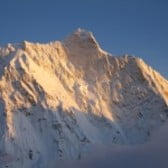
Daily Mountain
48 years, Australia
Interview: David Lama on His Lunag Ri Solo
Gazing up from base camp in 2015, David Lama and Conrad Anker repeatedly contemplated if that bare, rocky protrusion near the top of Lunag Ri could possibly be the true summit. It looked too improbable, too perfect.
But what if it was?
They failed to find out in 2015, turning around at 300 meters shy of the 6,895-meter summit. On a second attempt in 2016, things went haywire: Conrad Anker suffered a heart-attack around 5,800 meters. The pair rappelled to their advanced base camp, where Anker would be evacuated by helicopter to Kathmandu.
While they were waiting for the chopper at advanced base camp, Lama remembers Anker telling him, “Well, it’s on you now David.”
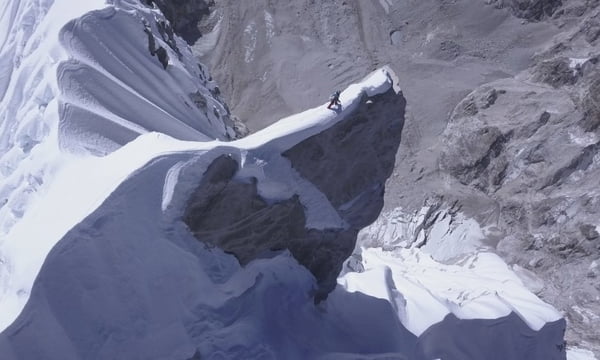 David Lama reaching the summit of Lunag Ri on October 25, 2018. Photo: Sean Haverstock / Red Bull Content Pool
David Lama reaching the summit of Lunag Ri on October 25, 2018. Photo: Sean Haverstock / Red Bull Content Pool
In the following days, after he learned that Anker had had surgery and was stable, Lama decided to try Lunag Ri by himself. Again, the mountain turned him away.
Upon his return home to Austria, Lama spoke to Anker. He told the older American alpinist that if he ever wanted to return to Lunag Ri, to say so; that he wouldn’t go back until Anker made a decision one way or the other; that he should take his time. It was a project the two had started together, and Lama respected that above any summit.
In spring 2018, Anker came with a reply. He couldn’t justify the risk posed by a third attempt on Lunag Ri. His wife and kids were too important.
And so Lama decided to return solo. In the fall of 2018, on his third expedition to Lunag Ri, an unclimbed mountain straddling the border between Tibet and Nepal, Lama spent three-days weaving along the west ridge to reach the mysterious summit.
And what he found? Those glimpses and guesses from base camp a few years were correct: the jaw-dropping summit was as beautiful as they come.
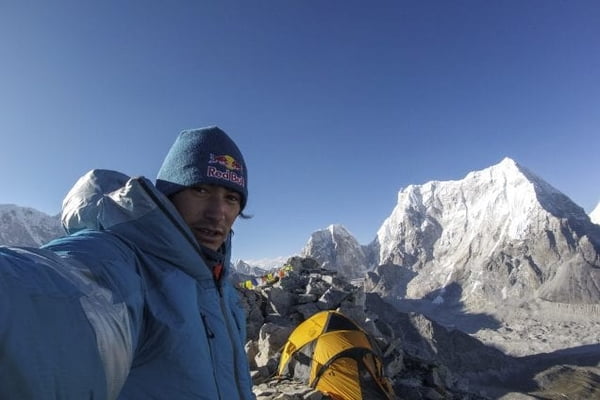 David Lama during acclimatization at Fox Peak on October 15, 2018. Lunag Ri is in the background. Photo: David Lama/Red Bull Content Pool
David Lama during acclimatization at Fox Peak on October 15, 2018. Lunag Ri is in the background. Photo: David Lama/Red Bull Content Pool
Rock and Ice caught up with Lama to hear about his climb. He was in the car on the way to the airport to catch a flight to the U.S., where he will be giving The North Face feedback on some of the specially-designed equipment they furnished him with to use on Lunag Ri.
Q&A with David Lama
So how does it feel now that you’ve wrapped up your Lunag Ri story?
Well it feels good, to be honest! You know, it’s been four years. When Conrad told me last spring that he wasn’t going to go back to Lunag Ri, that’s when I started thinking about this project again and really focusing on it.
There were a bunch of people—Colin Haley, also Jess Roskelley—who said that they’d be happy to join me. But I told them that I’d prefer to go back alone and give it another try by myself.
The reason was just that it was the most beautiful way to finish the project for both Conrad and I. So I’m super glad that it worked out that way.
I wish Conrad could have been up there on that summit with me, but in the end I was super happy that it was just me by myself if he couldn’t have been with me.
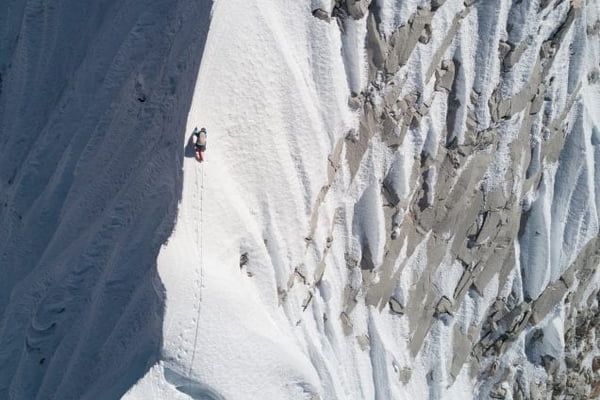 David Lama climbing up a the west ridge on October 24, 2018, during his solo first ascent of Lunag Ri, Himalayas . Photo: Martin Hanslmayr/Red Bull Content Pool
David Lama climbing up a the west ridge on October 24, 2018, during his solo first ascent of Lunag Ri, Himalayas . Photo: Martin Hanslmayr/Red Bull Content Pool
After the 2016 expedition, when Conrad had his heart attack and you tried solo, did you ever think, ‘That’s it, I’m not coming back?’ Or did you always know you would return?
I always knew I was going to go back. Over the past four years since our first attempt, I’ve felt more and more connected to the mountain in some ways. It was something that I wanted to bring full circle. Even if Lunag Ri had been climbed in the meantime, I would have still gone back and given it another try.
Everything that happened, it just brought up this connection within me to the mountain. I felt like I needed to do it.
When I decided that I would go back by myself, from then on my full attention has been on Lunag Ri. I focused on it and trained for it the entire summer. I just really wanted it.
How did you first hear of Lunag Ri? What makes it so special?
I first heard about it in 2013 when I was in Alaska and climbed the Moose’s Tooth. At base camp there was an American team and one of those guys— Chris Wright—he told me about Lunag Ri, that he’d been to the region. He showed me some photos. That was the first time that I heard of this peak.
I knew it wasn’t just some random unclimbed peak; it was a mountain that was going to be difficult to ascend. And with my background in hard sport climbing, technical difficulty is obviously something I’m interested in. So yea, I felt the need to go there and attempt the mountain myself
What is it about solo climbing that appeals to you?
When you’re climbing in a team with partners, we all have those moments where we question things: Is this the right decision? We have doubts. So when you’re by yourself the amount of confidence that you need is totally different.
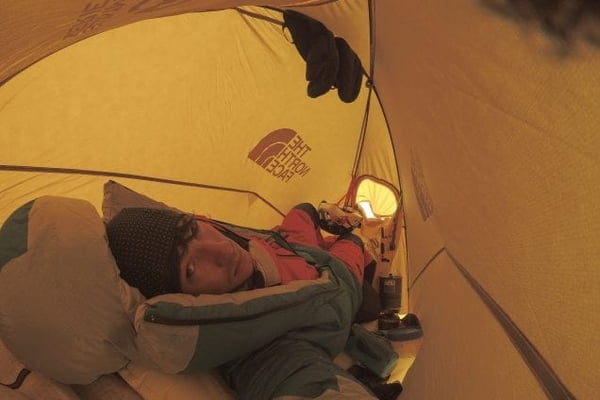 David Lama on October 23 in the first bivy during his solo first ascent of Lunag Ri. Photo: David Lama/Red Bull Content Pool
David Lama on October 23 in the first bivy during his solo first ascent of Lunag Ri. Photo: David Lama/Red Bull Content Pool
And the intensity of the confidence is also very different—you have to convince yourself during the whole expedition that your plan makes sense; that it’s worth the risk, the suffering, and all the things that come with mountain climbing.
That’s kind of a unique thing. In a team of two, anytime you have a small doubt, even if you don’t talk to your partner about it, just the fact that he is there, or pushing beside you, or doesn’t react to the same doubts—it is all a support system that makes it easier. By yourself you can’t rely on that.
So the ascent itself. Let’s hear it!
I was up there three days. I started on October 23, sometime between midnight and 2:00 a.m. I started that early because the lower part of the face is threatened by rock and icefall, so I wanted to avoid the sun hitting the face while I was on it.
At first I had some moonlight, then the moon disappeared, which made it quite tricky. The lower 1,000 meters of climbing this year was not covered in snow and ice. I really had to find the right connections between features—knew that would be one of the cruxes of the first day. But I ended up never dead-ending. I made my way through the lower part of the face exactly like I had imagined.
I got up onto the higher snow slopes and continued all the way to my first bivy. I spent about 24 hours there. The first day had really strong winds. They were predicted to be about 80 kilometers-per-hour, and it was minus 30 celsius. So I immediately put up my tent when I got to the bivy spot.
I woke up at 4:00 a.m. the next morning, and started climbing at 6:00 a.m. I stayed an hour longer than I had planned because the winds were so strong. The winds started to die down a bit then. I climbed the entire second day sometimes on the Tibetan side [of the west ridge], sometimes the Nepal side, but on the same basic line Conrad and I had done in 2015, and by myself in 2016.
Then climbed beyond our 2015 highpoint and put up my tent at a second bivy spot at about 6,800 meters. It was pretty high up on the mountain, just below the head wall. It was about 50 or 100 meters higher than our old high point.
From there, the third day was the big question mark. The headwall is this buttress; you can’t see the left side of it from anywhere on the route or from the lower camps. So there were some uncertainties about the line that I would pick. I knew it would have to be on left, Tibetan side, because the Nepalese side was far too steep.
I started day three at 6:00 a.m., traversed the ridge and even descended a bit. I left all my bivy gear behind and climbed as light as possible. I traversed some vertical ice slabs until I reached a system of gullies and ice slabs that I imagined would be climbable, but didn’t know if they would lead me all the way to the summit ridge.
I committed to the line I had imagined. Somewhere midway up those slabs I really had a bad feeling about my toes. I couldn’t feel my toes the entire third day. That’s where I really slowed down. I lost the confidence in my foot placements. It was very cold again. The winds weren’t as strong as the first day, probably about 30 kilometers-per-hour, so that made the cold a bit more manageable.
I tried to get feeling back in my toes and sometimes I could feel them again, but I had problems moving them around. At some point I got a bit of feeling back before it disappeared again, so I thought, ‘Well, if it came back once it’ll probably come back twice.’ So I decided to just keep going.
I moved up slowly even though the climbing was not too technically difficult. A a certain point I could see sun on the summit ridge. I could see how the terrain was getting less steep, and that’s when I was sure I was going to make it up. The terrain got a lot easier and at 10:00 a.m. I was on the summit. Spent a couple minutes up there and then started rappelling.
I rapped straight to my second bivy, picked up my gear, and continued immediately all the way to my first bivy. I stayed there for a couple hours, put up my tent again, brewed some water, and when the sun disappeared started my descent form the first bivy all the way to advanced base camp, which I reached a little before midnight .
You said elsewhere that you came close to your limit up there? What does that feel like?
I was worried about my toes getting frostbite. Friends of mine lost their toes. Peter Ortner, in particular. He lost his toes on Denali. He said he had started having problems moving his toes and they went from being ok to all of a sudden turning black. It happened quickly. So I knew that I was pretty close to the limit that I could stand.
Is it scary to think about how close to the edge you were?
It’s always good to see that line, but it’s always hard to see it until you cross. Since I didn’t cross it, it’s great, but it feels like I was really close.
It’s something that you just simply have to accept to a certain degree. It’s not like you press a button and you’re in a different world sitting in a hot tub where your feet get warm instantly. You’ll still have to get off the mountain when you decide to descend.
In mountaineering, it’s all about making decisions and looking far ahead, so the looking far ahead part—I committed to getting cold feet, to the shoes I wore, to the sock system I used, and to all the consequences that came with those things. My feet were really cold, but I’m really happy that I didn’t get any frostbite and I came back with all my toes!
That summit—what a summit! Pretty special, yea?
The summit is just a place where you can kind of relax for a brief moment. You reorganize yourself for the descent, so you have a brief moment to suck up all the views and just stand up there and enjoy it for a brief moment. And then after a little while you start preparing for your descent. So you don’t spend long up there. But it certainly was a special moment.
How technically challenging was the climbing?
In 2016 it was certainly really difficult climbing on the ridge. This year it was easier terrain a bit. Some of the slabs that in 2016 were covered in snow and ice, so I could work my way up.
But the headwall definitely had some technical difficulties. At one particular spot I was below a little roof. I placed a cam there and climbed over the roof. That was already a moment where I could see the summit ridge and knew I was super close. So I was desperately moving forward not knowing what was still ahead.
These days you focus more on alpinism than sport climbing. What factors into that?
Alpine climbing just seems more exciting to me these days. It’s the place where my heart is at this moment and where I see my future.
I really love the combination of ice, rock and snow in mountaineering and alpinism. I think it’s incredibly challenging to always decide which line and what route and what conditions and how are you going to make the best of what the mountain gives you.
It’s just a bigger and more complex challenge overall. It’s something that really inspires me right now.
What’s next for you?
I have a couple of winter ascents back home in Austria that I’d love to do. Big expedition plans for next year are not really concrete at this very moment, but I have a bunch of ideas. I’m not sure exactly where it will take me. But I’m super excited.
By Michael Levy
This article first appeared on https://rockandice.com. The original can be read here.

